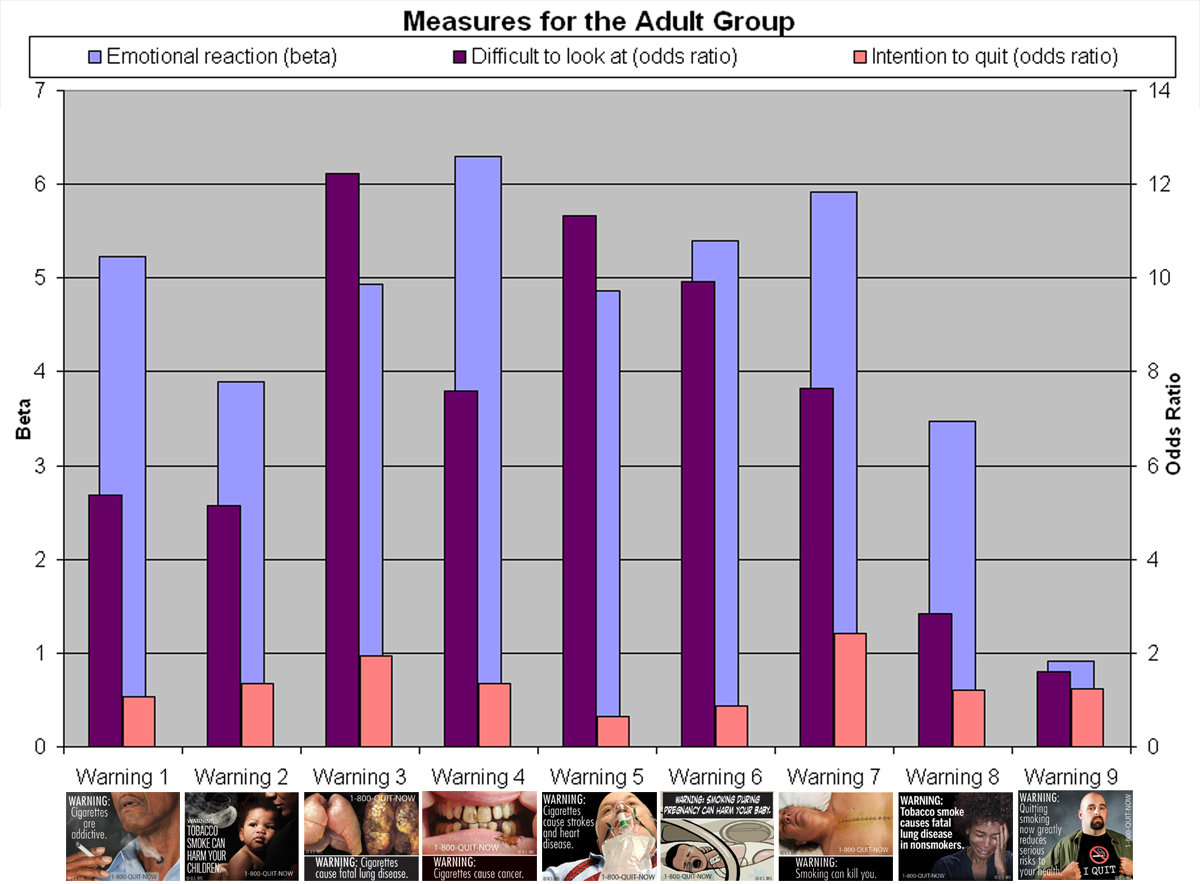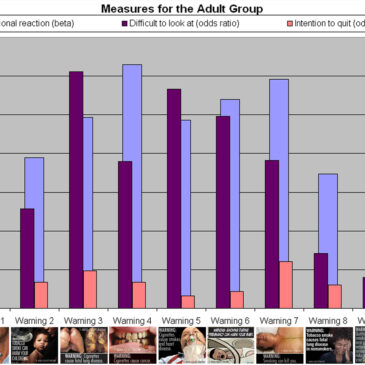Beginning in September 2012, the United States Food and Drug Administration (FDA) will require cigarette companies to include new health warning statements and accompanying graphic images on cigarette packs and advertisements (U.S. Food and Drug Administration, 2011). In a previous Addiction & the Humanities, we reviewed critics’ claims that graphic warning labels, while emotionally impactful, might not be particularly effective in changing behavior. This week’s ASHES reports on a recent study the FDA used to inform their selection of graphic warning images (Nonnemaker, Farrelly, Kamyab, Busey, & Mann, 2010). The FDA designed the study to evaluate the relative efficacy of 36 proposed warning images and used study findings, along with public comments and a scientific literature review, to winnow the 36 proposed images to nine.[1]
Methods
- The FDA used an online research company to recruit participants randomly using a convenience sample of adult smokers (age 25+; n = 4,890).
- The control group saw only warning statements and the treatment group saw both statements and graphic images.
- Participants described how much the packs made them feel a variety of emotions (e.g., worried, depressed, disgusted). Researchers combined the items onto a single scale where higher values indicate more emotional responses.
- Participants described the extent to which the material was difficult to look at.
- Participants described their intention to quit smoking in the next 30 days.
- For all statistical analyses, the researchers entered experimental condition (i.e., control versus treatment) as an independent variable and outcomes as dependent variables, controlling for demographic characteristics. The researchers used linear regression to interpret continuous measures (i.e., emotional reaction) and logistic regression to interpret the dichotomous measures (i.e., difficulty looking at the pack and intent to quit smoking) that were derived from exposure to the images.
Results
- Figure 1 displays the results for each of the nine warning statements ultimately selected.
- The accompanying graphics for all warning statements except # 9 (i.e., “Quitting smoking now greatly reduces serious risk to your health.”) significantly heightened the participants emotional response.
- Participants reported that the packs were significantly more difficult to look at when accompanied with graphic images than without, except for warning statement #9.
- The warning statements accompanied with graphics did not have a significant impact on self-reported smoking cessation plans except for warning statement 7 (“Smoking can kill you”). Graphics accompanying that statement resulted in more likely intentions to quit smoking.

Figure. Adult Group Results (adapted from Nonnemaker, et al., 2010). Click image to enlarge.
Note: More positive betas indicate stronger emotional reactions among people who viewed both warning statements and accompanying images (i.e., the treatment group). Odds ratios greater than 1 indicate greater likelihood of experiencing the outcome among the treatment group.
Limitations
- The study uses self-report to estimate future actions; the “behavior” of ceasing smoking is a self-report of participants’ beliefs and thoughts about their potential future action, not an observation of their actual behavior following the study. Stated intentions and the actual behaviors often are discrepant.
- The study uses a convenience sample, and the sample was predominantly Caucasian. These results might not generalize to other groups.
- Participants only saw the cigarette package once during the study. A longitudinal study of exposure over time to warning statements and labels (i.e., repeated doses) might have had a different effect (e.g., stronger or weaker) on participants’ desire to quit smoking.
Discussion
Perhaps most startling about this research is that, although people seem to have strong reactions to the graphics accompanying the warnings, this reaction did not have an effect on their plan to quit smoking. Quitting smoking is a main goal of the new labels (i.e., increase smoking cessation). A population-based longitudinal study measuring actual future smoking behavior before and after the introduction of the new warning labels could be a better indicator of the effectiveness of these materials.
The United States experienced a significant decline in tobacco use during the last 40 years. However, those rates of decline have recently begun to level out. Estimates reveal that 20.6% of adults and 19.5% of students in high school are current smokers (U.S. Department of Health & Human Services). From a public health standpoint, the remaining smokers’ behavior might be the most difficult to change. It will be interesting to see if new warnings have an impact.
–Tasha Chandler
References
Nonnemaker, J., Farrelly, M., Kamyab, K., Busey, A., & Mann, N. (2010). Experimental study of graphic cigarette warning labels. Research Triangle Park, NC: RTI International.
U.S. Department of Health & Human Services. Tobacco prevention and control: New actions to end the tobacco epidemic Retrieved Jul. 13, 2011, from http://www.hhs.gov/tobaccocontrol/index.html
U.S. Food and Drug Administration. (2011, Jun. 22). Cigarette Health Warnings Retrieved Jul. 13, 2011, from http://www.fda.gov/TobaccoProducts/Labeling/CigaretteWarningLabels/default.htm
What do you think? Please use the comment link below to provide feedback on this article.
________________
[1] Although the study reported about all 36 proposed graphic images to accompany the nine new warning statements, this week’s ASHES only reports about the nine graphic images that were selected. The study also included a young adult smoking group (18-24) (n=4,584) and a group comprised of youth smokers and youth susceptible to smoking (13-17) (n=4,600), as well as other study measures. We only report about the outcomes for the adult smoking group for certain measures.





VAPORS January 16, 2017
I Never ever found such edifying blogs.
VAPORS